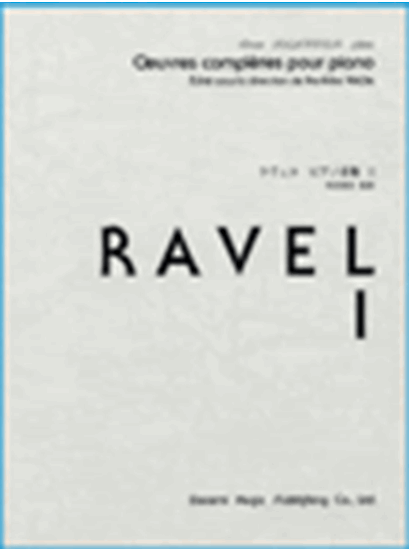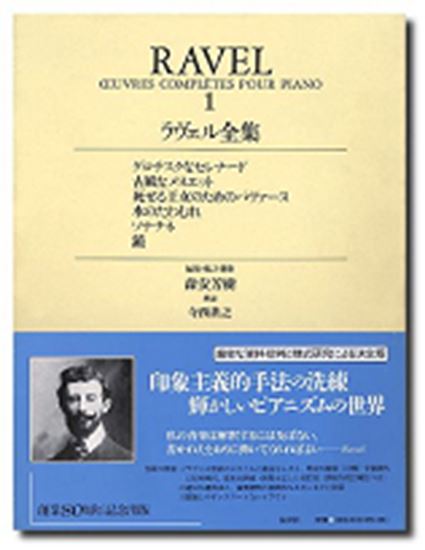Ravel, Maurice : Miroirs
Work Overview
Publication Year:1906
First Publisher:Demets
Instrumentation:Piano Solo
Genre:pieces
Total Playing Time:26 min 30 sec
Copyright:Public Domain
Commentary (2)
Author : PTNA Piano Encyclopedia Editorial Department
Last Updated: January 1, 2010
[Open]
Author : PTNA Piano Encyclopedia Editorial Department
1. Moths / "Noctuelles"
2. Sad Birds / "Oiseaux tristes"
3. A Boat on the Ocean / "Une barque sur l'océan"
4. The Jester's Morning Song / "Alborada del gracioso"
The fourth piece of the five-movement suite Miroirs. This piece is imbued with Spanish sentiment, frequently employing rhythms from Spain, the homeland of Ravel's mother, and featuring imitations of Spanish guitar, with its title also written in Spanish. Brilliant performance techniques, such as irregular, energetic rhythms, rapid repetitions, and double glissandos, are effectively presented within its rich and exotic expression.
5. The Valley of Bells / "La vallée des cloches"
Author : Tachi, Arisa
Last Updated: March 12, 2018
[Open]
Author : Tachi, Arisa
A five-movement suite with programmatic titles, composed between 1904 and 1905. It was premiered in 1906 at a concert of the Société Nationale de Musique, at Salle Érard, by the Spanish pianist Ricardo Viñes (1875-1943), who had long been close to Ravel.
The period from 1900 to 1905 was a turbulent time in Ravel's life as a composer. He attempted the Prix de Rome, a gateway for aspiring artists in France at the time, five times, but not only failed to win the Grand Prize on any occasion, but was even eliminated in the preliminary round on his fifth attempt. This situation sparked controversy over the fairness of the prize's judging, leading to the resignation of Théodore Dubois (1837-1924), director of the Paris Conservatoire. This scandal, known as the "Affaire Ravel," highlighted the anti-academic aspect of his compositional style.
While all the works Ravel wrote for the Prix de Rome were vocal pieces, he was simultaneously working on the piano works Jeux d'eau and Sonatine. Miroirs is a work that reveals Ravel's continued exploration of pianism following these two earlier pieces, and it also marks the culmination of his first creative period. Compared to Jeux d'eau and Sonatine, the melodic lines and phrases are further blurred, and the succession of shifting harmonies and small motifs enters the listener's ear as if forming a long, sustained melody. Furthermore, many of the musical idioms developed in Miroirs were later applied in Gaspard de la nuit, written in 1908.
As an explanation for the title Miroirs, which is popularly known as "Mirrors" in Japan, Ravel quoted Brutus's line from Act I of Shakespeare's Julius Caesar in his Esquisse autobiographique (an interview record transcribed in 1928 and published in 1938): "The eye sees not itself, but by reflection, by some other things." (This line appears as an answer to Cassius's question about whether Brutus has ever seen his own face). Ravel himself stated that he quoted this line to show that he was the antithesis of a subjective artistic stance, meaning he perceived his subjects objectively. However, considering the context of the line, it can also be interpreted that Ravel himself is projected onto the subjects depicted in each piece.
Each piece is dedicated to a member of the artistic group "Les Apaches" (for details, refer to the commentary on each piece).
No. 1: Noctuelle
Dedicated to the poet Léon-Paul Fargue (1867-1947). The piece itself is said to have been inspired by Fargue's poetry. It is in D-flat major and in A-B'-A' form, but it is written to sound improvisatory through the combination of changing meters (often including variations with 5/4 time) and motifs with differing periodicities.
The A section can be divided into 9-bar, 11-bar, and 16-bar segments, separated by rests that abruptly halt the musical motion. In the opening 9 bars, the appearance of a moth fluttering its wings at night is depicted through the combination of a jerky motif in 4/4 time, characterized by chromatic horizontal movement and double stops of thirds and fourths, and smoothly arcing eighth/sixteenth notes in 3/4 time. The next 11 bars begin with similar motion, but a semblance of a melodic line finally emerges, and in the subsequent 16 bars, relatively long note values appear in the left hand, leading into the B section. The B section modulates from D-flat major to its parallel minor, B-flat minor, with the dominant F and tonic B-flat persistently repeated in syncopation. A long phrase, seemingly the main melody and containing many non-harmonic tones, appears in the right hand, but it eventually fragments and is reduced to the motifs used in the A section, leading to the A' section. The A' section is shorter than the A section, without divisions, and concludes with an 11-bar coda.
No. 2: Oiseaux tristes
Dedicated to Ricardo Viñes himself, who premiered the work, this is the shortest of the five pieces, yet it clearly suggests tonal shifts. It is in E-flat minor.
The repeated B-flat at the beginning of the piece transforms in the next bar into a melancholic motif that clearly presents E-flat minor. In the following bar, the tonic E-flat is repeated, followed by the leading tone D-natural, but this D-natural does not return to the tonic; instead, it combines with the dominant B-flat to form a motif, creating an unsettling atmosphere. Simultaneously, in the inner voices, a chromatic figure in units of three beats appears, resisting the initial 4/4 time signature (the upper staff begins in 4/4 while the lower staff begins in 12/8), further stagnating the musical flow. In the uppermost voice, the repeated B-flat and E-flat continue to alternate, but in bar 10, E-flat transforms enharmonically into D-sharp, and the piece modulates to E major. In bar 13, the inner voices, which had been moving in eighth notes, double their speed to sixteenth notes, and the music suddenly bursts into motion. Returning to its original stagnant flow in bar 20, the music modulates to D minor via the C-sharp contained within E major. Although it accelerates again in bar 25, there is no further expansion in volume; instead, the music moves towards the coda, repeating the opening motif in the high register and pianissimo.
No. 3: Une barque sur l'océan
A lengthy piece dedicated to the painter Paul Sordes. The continuous arpeggios and floating eighth notes, shifting in rhythmic units, create an impression of ceaseless motion. However, focusing on the characteristic motifs, the form can be interpreted as a free rondo-sonata, structured as A-B-transition-A'-B'-C-transition-B''-A.
While the motif of the A section possesses a gentle and static atmosphere due to the repetition of identical figures and the sound of minor seventh chords, the motif of the B section has a strongly dynamic atmosphere, characterized by sharp-sounding tremolos with semitones and intensely ascending/descending arpeggios with minor triads. In the C section, diminished intervals, augmented intervals, and semitones are incorporated more boldly within the repetition of identical figures, creating a sense of tension. However, when the B section returns, the music flows back to the gentle atmosphere created by the opening A section, and finally, the exact same motif as the opening A section appears, bringing the piece to a quiet close.
Incidentally, Ravel wrote an orchestral version of this piece in October 1906, but later forbade its performance himself.
No. 4: Alborada del gracioso
Dedicated to the musicologist M. D. Calvocoressi (Michael Dimitri Calvocoressi, 1877-1944). This piece is somewhat distinct among the five, with its dance-like character prominently featured. Ravel, who had Basque ancestry, had a strong interest in Spain and left many works inspired by the country, such as the opera L'heure espagnole and the orchestral work Rapsodie espagnole. However, 'Alborada del gracioso' is not merely a 'Spanish-style' piece; it also reveals Ravel's keen sensitivity to harmony and rhythm.
The entire piece is in a clear ternary form, contrasting an A section where ornamental and melodic figures are inserted into chords that strictly mark the tempo, with a B section where dance-like fragments are inserted into a broadly sung melody that, conversely, fluctuates in tempo. The opening of the piece is in the Phrygian mode with D as the root, augmented by F-sharp and C-sharp. However, the tonality is ambiguous because F-sharp can be interpreted as either a scale degree or an ornamental note, and C-sharp does not function as a leading tone. As the root shifts from D to B-flat to D-flat, major triads sound as tonic chords, and upon entering bar 43, a V-I progression in C-sharp minor is presented, clarifying the tonality. The A section then concludes brilliantly with a D major cadenza. The beginning of the B section also extends this, starting with a declamatory melody in D major, but each time a chord is inserted, the leading-tone function of C-sharp weakens (or C-natural frequently appears instead of C-sharp), and the music takes on an enchanting atmosphere, oscillating between major and minor with B as the root. Within this, a syncopated rhythm that blurs the metric divisions appears in the right hand, contrasted with the urgent movements of the left hand, reminiscent of dance steps. In the A' section, the root shifts from E-flat to F-sharp, leading the listener to expect a cadenza in F-sharp minor. However, contrary to this expectation, bar 175 presents a progression of C-sharp → B-flat / A / G, and the music continues to shift roots, blurring the tonality, until it finally returns to A (the dominant of D) → D (same as the opening) in the coda from bar 200 onwards. The piece concludes brilliantly with the D major tonic chord played resoundingly.
No. 5: La vallée des cloches
Dedicated to Maurice Delage (1879-1961), Ravel's pupil and friend. The root C-sharp ≈ D-flat, the opening uppermost voice figure alternating between thirds and fourths, and the improvisatory-sounding melodic movement due to changing meters correspond to the first piece, 'Noctuelle.' However, the distance between voices created by the extensive use of three staves and the hollow sound resulting from the frequent perfect intervals, conversely, give the listener a contrasting sense of openness. While the piece can be clearly divided into A-B-A' sections by key, further dividing the A section by the nature of its motifs reveals a symmetrical structure of a-b-c-b'-a'. In sections a and a', sextuplets with double stops of fourths (changing to thirds midway through section a) and octave leaps are played softly, as if depicting the echoing and lingering sound of bells in a valley. In sections b and b', fourth-descending progressions with denser chords are played, imitating the sound of bells themselves. The c section is distinct from sections a and b, possessing a clear melodic line that, as it moves from the middle voice to the upper voice, evokes classical polyphony rather than layers of sound imitating bell resonances. If this melodic line is interpreted not as the 'bells' themselves but as 'music within the church where the bells are ringing,' then throughout this piece, the composer's perspective can be seen as zooming in from a 'panoramic view of the bell-echoing valley' to 'the church in the valley where the bells are ringing' to 'the music inside the church,' and then zooming out again.
Movements (5)
PTNA & Partner Channel Videos(34items) View More
Reference Videos & Audition Selections(3items)
Sheet Music
Scores List (7)

(株)ヤマハミュージックエンタテインメントホールディングス

(株)音楽之友社

(株)ドレミ楽譜出版社

(株)全音楽譜出版社

(株)ドレミ楽譜出版社

(株)全音楽譜出版社

(株)春秋社


















